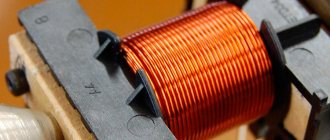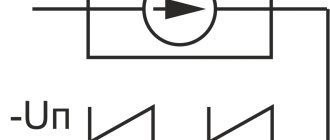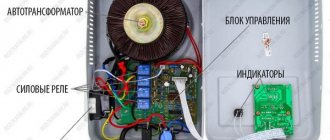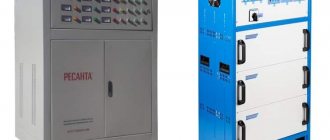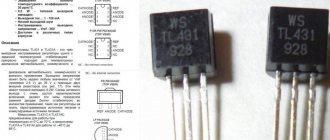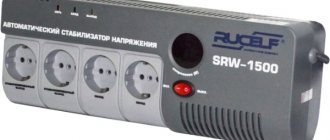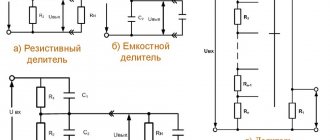Currently, there is a downward trend in demand for electric generators with manual control and an increase in demand for generators with an automatic starting system. Such devices are more modern and respond promptly during a power outage, providing uninterrupted power supply to the connected load, be it a residential building or an industrial-scale structure. But, if a voltage stabilizer is not installed together with the generator, then in the realities of the Russian power system, the automatic switching function can cause increased fuel consumption and rapid wear of the generator.
Why is a stabilizer necessary for a generator?
The essence of the problem is that complete power outages are not common; fluctuations in mains voltage are more common. In this case, a drop even to 160-170 V is enough to automatically turn on the generator. That is, the device will operate and consume fuel if there is electricity in the network, which can simply be adjusted to the required parameters.
The automatic starting system turns on the generator even at increased voltage - more than 230 V. Of course, network parameters fall more often than they rise, but in the immediate vicinity of industrial enterprises, voltage surges above normal are a common occurrence.
Another common reason for the automatic start of a generator set is a short-term, literally a split second, interruption in the power supply, after which the voltage in the network is restored. It is worth noting that the starting systems of modern generators stop the operation of the device when electricity appears. But, firstly, not all models have this function, and, secondly, the system may simply not catch the moment the mains power is turned on after a lightning break, as a result of which the power plant will continue to operate, consuming fuel unnecessarily.
A voltage stabilizer that neutralizes network surges will solve the problems listed above. Receiving voltage from the output of the stabilizer, the generator will start only in the event of a real power outage. Consequently, the use of an automated generator in conjunction with a stabilizer will avoid unnecessary starts of the device, which will protect its mechanical elements from premature wear and significantly reduce fuel consumption. The above allows us to confidently say that purchasing a high-quality voltage stabilizer will quickly pay for itself!
ELECTRICAL EQUIPMENT
Compatibility of generator and voltage stabilizer.
It will not be news to anyone that electric generators are one of the main sources of backup power in the event of interruptions or lack of voltage in the power grid. Temporary provision of electricity is their main task. Starting of electric generators is carried out manually, or automatically using the automatic transfer unit “AVR”. When using a generator with manual start, the owner of the generating station must start the generator himself manually or with a key or button (if the generator has an electric starter system). This creates certain inconveniences in using the power plant, if the power plant is located in another room or at a certain distance.
It will still be more comfortable and efficient to use generating stations with automatic start, which will allow the system to operate completely autonomously, without human presence. The automatic start system will independently start the electric generator and timely necessary shutdown of the generator when power is supplied to the industrial network. The automatic generator start system autonomously analyzes the network voltage parameters, i.e. when the mains voltage goes beyond the operating range or during a power outage, the automatic power generator will automatically disconnect the consumers connected to the circuit from the external power grid, start the generating station and supply electricity from it. As soon as the voltage in the external network appears or enters acceptable limits, the automation system will switch the connected consumers to the external network and shut down the generating station.
During the operation of power plants with an automatic transfer system, a situation may arise when the automation will try to switch to supplying electricity from a backup source (generator), while voltage is still supplied to the external network. This situation is possible if voltage is present in the electrical network, but with a value outside the permissible limits (range). As a rule, this happens at very low voltage. The automation of electric generators is triggered by voltage surges below 195V and above 235V.
It is in this situation that we strongly recommend that you use the generator station “in one circuit” with a voltage stabilizer. In this case, it will be possible to avoid unnecessary and unnecessary starts of the power plant. This combination of stabilizer and generator will help correct the voltage situation in the industrial network. If there is a voltage in the network that is outside the permissible operating range of the generator automation, the stabilizer will correctly adjust it to a stable 220V (or 380V in the case of a three-phase network) with fairly high accuracy (will depend on the type of voltage stabilizer). As a result, this will allow the generator automation to operate stably at normal voltage, without unnecessary and unnecessary operations.
What is the correct sequence for connecting the stabilizer and generator?
It should be understood that the generator and stabilizer, like any electrical appliances, are high-risk products, the incorrect installation of which can lead to equipment damage, serious injury or death. Therefore, we strongly recommend that you trust the installation and connection of such equipment only to a professional – certified specialist!
If a stabilizer is needed to solve the problem of the automatic starting system responding to short-term outages and voltage surges, then the correct connection sequence is:
- 1) electric meter;
- 2) voltage stabilizer;
- 3) generator;
- 4) load.
Installing a stabilizer after the generator will not save the latter from unnecessary starts, since the mains voltage will first reach the generator and only then pass through the stabilizer. However, a situation may arise in which the output voltage of the generator will not meet the requirements for the quality of power supply to the connected load. In this case, it is possible to connect another stabilizer to the output of the generator, which will regulate the voltage transmitted to direct consumers, but not the voltage of the input network!
What type of stabilizer is best to use when connecting in front of the generator?
In principle, for connection in front of the generator, that is, for protection against negative influences from the external network, any of the four most common stabilizer topologies is suitable:
- relay;
- electromechanical (servo-drive);
- semiconductor (thyristor and triac);
- inverter
But practice shows that semiconductor and inverter stabilizers, these devices, cope best with solving this problem:
- characterized by high response speed;
- operate over a wide input voltage range, which allows minimizing the number of generator starts;
- have better stabilization accuracy (low error), which is important for the correct functioning of the electronics of the automatic starting system;
- durable and maintenance-free.
The cost of semiconductor stabilizers is usually slightly lower than inverter ones, but inverter devices are distinguished by greater accuracy and speed, and, in addition, they are freed from the main problem inherent in more or less all other types of stabilizers - the transmission of disturbing influences from the external network to the output of the device. Thanks to this, with almost any quality of the external power supply, inverter stabilizers will provide power to the generator with a voltage with an ideal sinusoidal shape and a value as close as possible to the nominal one (±2%).
What type of stabilizer is best to use when connecting after the generator?
Connecting a stabilizer after the generator is associated with some problems, the main one of which is the sawtooth shape of the voltage produced by the generator, the frequency of which can vary from 48 Hz to 52 Hz. Under conditions of such an input signal, any stabilizer other than an inverter one will not be able to work normally and will sooner or later fail.
In addition, the load in the form of a stabilizer negatively affects the generator, which is characterized by reduced speed at startup, causing a drop in the output voltage. At this moment, the stabilizer tries to increase the voltage and begins to switch the windings of the autotransformer, thereby complicating the operation of the generator.
Inverter stabilizers are free from the above problems. These devices have a wide input frequency range - 43-57 Hz and adjust the shape of the input voltage, which ensures an ideal sinusoidal output signal even when powered by a generator. In addition, the absence of an autotransformer in the design makes it possible to reduce the reverse influence of the inverter stabilizer on the generator.
How to determine the stabilizer power for a generator?
If a stabilizer is installed in front of a generator, the power of the device must be no less than the rated power of the generator; it is advisable to have a reserve of 20-30%, taking into account possible overloads.
When choosing a stabilizer for installation after a generator, you need to focus on the load connected directly to the stabilizer. The current power of the device in this case is equal to the load power increased by a margin of 20-30%. If there are several consumers, then their power is summed up, and the reserve is determined based on the value obtained by the summation.
All devices containing an electric motor are characterized by the presence of high starting currents. When determining the stabilizer power for such electrical appliances, it is necessary to use not the rated power, but the maximum starting power (usually 3 times the standard minimum).
When choosing a stabilizer, be sure to study the technical documentation of the protected equipment and find information about power consumption in various operating modes. The power of the stabilizer is determined by the maximum of the given values!
Currently, there is a downward trend in demand for electric generators with manual control and an increase in demand for generators with an automatic starting system. Such devices are more modern and respond promptly during a power outage, providing uninterrupted power supply to the connected load, be it a residential building or an industrial-scale structure. But, if a voltage stabilizer is not installed together with the generator, then in the realities of the Russian power system, the automatic switching function can cause increased fuel consumption and rapid wear of the generator.
Generator operation
Based on their operating principle, generators are divided into types:
- With manual control.
- With automatic control.
Manually operated generators are activated by a person when problems are detected in the main power supply. This method is not very efficient, since when connecting highly sensitive devices, a lot of time elapses between the power outage and the start of the generator. It is not possible to prevent power surges using a generator. Therefore, hand generators are not very popular.
Today, generators with automatic operation are especially widely used by monitoring the operation of the electrical network. It starts automatically when there is a network outage. When the network operation is normalized, the generator immediately turns off on its own, and the operation of all electrical devices switches to the main network.
Such an automatic system makes it possible to provide constant power to various devices. However, it has a disadvantage: the generator can start even when the main network is working. Such inclusion is possible when the network voltage drops sharply for a short time. The automation works erroneously and mistakes this decrease in power for a network outage.
The use of a generator together with a stabilizer connected to the network in front of the generator solves this problem. Now the generator will only start if there is a real power outage. The stabilizer will not allow the generator to start during small power fluctuations in the network.
Why is a stabilizer necessary for a generator?
The essence of the problem is that complete power outages are not common; fluctuations in mains voltage are more common. In this case, a drop even to 160-170 V is enough to automatically turn on the generator. That is, the device will operate and consume fuel if there is electricity in the network, which can simply be adjusted to the required parameters.
The automatic starting system turns on the generator even at increased voltage - more than 230 V. Of course, network parameters fall more often than they rise, but in the immediate vicinity of industrial enterprises, voltage surges above normal are a common occurrence.
Another common reason for the automatic start of a generator set is a short-term, literally a split second, interruption in the power supply, after which the voltage in the network is restored. It is worth noting that the starting systems of modern generators stop the operation of the device when electricity appears. But, firstly, not all models have this function, and, secondly, the system may simply not catch the moment the mains power is turned on after a lightning break, as a result of which the power plant will continue to operate, consuming fuel unnecessarily.
A voltage stabilizer that neutralizes network surges will solve the problems listed above. Receiving voltage from the output of the stabilizer, the generator will start only in the event of a real power outage. Consequently, the use of an automated generator in conjunction with a stabilizer will avoid unnecessary starts of the device, which will protect its mechanical elements from premature wear and significantly reduce fuel consumption. The above allows us to confidently say that purchasing a high-quality voltage stabilizer will quickly pay for itself!
Distribution board diagram with a “network-generator” switch
Details Published: 04 June 2015
In dacha areas, garden plots, the private sector and similar places, frequent power outages are common. Here they can turn off the lights for an hour, for the whole day or for a longer time. This creates quite a few problems, since people can no longer imagine life without electricity. He has things working at home: a refrigerator, a TV, room lighting, a pump for watering the garden, and the like.
Gasoline power plants are very popular in such places. Turn off the lights, start the gas generator and continue to enjoy life. The power plant must be connected to the distribution board through a special outlet. Below I look at the diagram of a distribution board with a “mains-generator” switch, which allows you to switch to power supply from a gas generator when the external network is lost and back.
Here I am considering manual switching, which is carried out using a reversing switch. All diagrams show an ABB OT40F3C switch. This is a high-quality and reliable reversible switch. It has three positions:
- the handle is turned to the left - the contacts on its left side are closed, and on the right side they are open;
- the handle is in a vertical position - all contacts are open (both right and left);
- the handle is turned to the right - the contacts on its right side are closed, and on the left side they are open.
If what is written is not entirely clear, then look at the latest diagram and you will immediately understand how it works.
It is worth noting that if you take such a reversing switch for a higher current, then the switch handle is not included in the kit. It must be purchased separately.
Below is a simple single-phase switchboard diagram with a mains-generator switch. This is plenty for a small dacha or garden house. If you have a large house, then you need to revise the ratings of the input machine and increase the number of group lines. Everything is individual here.
It is very convenient to use a network indicator in such panels. For example, the signal lamp LS-47. Why is she needed here? Let's say the lights are turned off and you start the power plant. Everything is working.
Next, how to determine whether there is voltage in the network or not? You won’t run to the switchboard every half hour and use an indicator to check whether the light is on or not. This is not convenient and is forgotten over time. So you can miss this moment and “sit” on the gas generator until the evening. And gasoline is expensive these days.
In such a situation, the mains voltage indicator will immediately show you when the light comes on
It will just light up and you will immediately notice it. It is clearly visible from afar even through the transparent cover of the shield
As soon as the warning light came on, they immediately turned off the power plant and switched the switch to mains mode.
Below is the same diagram of the distribution board, but with an LS-47 signal lamp.
If you want to protect yourself and your dacha from current leaks, then you need to install an RCD. Below is a diagram with one common protective device. If you want more, then go ahead and fight. Here you can fantasize endlessly.
For a better understanding of the operation of such a circuit, I schematically showed the state of the contacts of the reversing switch with red lines and the direction of the current with red arrows.
Below is the work from an external network.
And here the work from a gas generator is already presented.
And these are already two diagrams of the operation of this switchboard in one. It looks like a cartoon. Like?
At the request of site visitors, I am posting below a 3-phase electrical panel diagram with a “network-generator” switch
Also don't forget to smile:
A drunk man goes home and hits his head on every lamppost. Then an acquaintance meets him and asks: “Why are you hitting the pillars like that, why are they bothering you?” Can't get around? “That’s not the point at all, it’s just how I determine the way home.” - Didn't understand. - What’s incomprehensible here? Here are 3 more pillars along this street, then 7 more along another - and I’m home.
What is the correct sequence for connecting the stabilizer and generator?
It should be understood that the generator and stabilizer, like any electrical appliances, are high-risk products, the incorrect installation of which can lead to equipment damage, serious injury or death. Therefore, we strongly recommend that you trust the installation and connection of such equipment only to a professional – certified specialist!
If a stabilizer is needed to solve the problem of the automatic starting system responding to short-term outages and voltage surges, then the correct connection sequence is:
- 1) electric meter;
- 2) voltage stabilizer;
- 3) generator;
- 4) load.
Installing a stabilizer after the generator will not save the latter from unnecessary starts, since the mains voltage will first reach the generator and only then pass through the stabilizer. However, a situation may arise in which the output voltage of the generator will not meet the requirements for the quality of power supply to the connected load. In this case, it is possible to connect another stabilizer to the output of the generator, which will regulate the voltage transmitted to direct consumers, but not the voltage of the input network!
Please note - not all types of stabilizers will be able to function correctly when connected after the generator!
Connecting a single-phase voltage stabilizer
Some manufacturers do not inform the buyer in their data sheets how to properly connect the stabilizer. If you purchased and do not have such information, you can contact the manufacturer, but in most cases you can connect it yourself using the following terminal block:
Connecting the stabilizer via the terminal block
Please note - in all phase stabilizers there are zeros at the edges of the terminal block (left - input, right - output), closer to the center, and ground in the middle!
Such terminals are used for stabilizers with a power of more than 5 kW. For powers up to 5 kW, as a rule, a conventional grounding plug is used for connection, and sockets on the stabilizer body are used to connect consumers.
For ease of understanding, I will give a typical input circuit of apartment wiring:
Wiring diagram for an apartment or house without connecting a stabilizer
It is worth saying that the input (general, main) two-pole circuit breaker can be installed both BEFORE and after the meter. Next, after the meter, there should be circuit breakers for groups of loads (sockets, lighting, etc.)
More information about apartment electrical wiring and the choice of group machines for it is here.
The stabilizer must be connected after the meter. And in front of the stabilizer there should be a circuit breaker that will remove power from the stabilizer if necessary.
The wiring diagram with a connected stabilizer will be like this:
Voltage stabilizer connection diagram
I repeat - the circuit breaker can be placed BEFORE and/or AFTER the meter, but always BEFORE the stabilizer.
The figure shows the connection diagram for SUNTEK voltage stabilizers.
Diagram for connecting a stabilizer to a single-phase network
What type of stabilizer is best to use when connecting in front of the generator?
In principle, for connection in front of the generator, that is, for protection against negative influences from the external network, any of the four most common stabilizer topologies is suitable:
- relay;
- electromechanical (servo-drive);
- semiconductor (thyristor and triac);
- inverter
But practice shows that semiconductor and inverter stabilizers, these devices, cope best with solving this problem:
- characterized by high response speed;
- operate over a wide input voltage range, which allows minimizing the number of generator starts;
- have better stabilization accuracy (low error), which is important for the correct functioning of the electronics of the automatic starting system;
- durable and maintenance-free.
The cost of semiconductor stabilizers is usually slightly lower than inverter ones, but inverter devices are distinguished by greater accuracy and speed, and, in addition, they are freed from the main problem inherent in more or less all other types of stabilizers - the transmission of disturbing influences from the external network to the output of the device. Thanks to this, with almost any quality of the external power supply, inverter stabilizers will provide power to the generator with a voltage with an ideal sinusoidal shape and a value as close as possible to the nominal one (±2%).
What type of stabilizer is best to use when connecting after the generator?
Connecting a stabilizer after the generator is associated with some problems, the main one of which is the sawtooth shape of the voltage produced by the generator, the frequency of which can vary from 48 Hz to 52 Hz. Under conditions of such an input signal, any stabilizer other than an inverter one will not be able to work normally and will sooner or later fail.
In addition, the load in the form of a stabilizer negatively affects the generator, which is characterized by reduced speed at startup, causing a drop in the output voltage. At this moment, the stabilizer tries to increase the voltage and begins to switch the windings of the autotransformer, thereby complicating the operation of the generator.
Inverter stabilizers are free from the above problems. These devices have a wide input frequency range - 43-57 Hz and adjust the shape of the input voltage, which ensures an ideal sinusoidal output signal even when powered by a generator. In addition, the absence of an autotransformer in the design makes it possible to reduce the reverse influence of the inverter stabilizer on the generator.
How to determine the stabilizer power for a generator?
If a stabilizer is installed in front of a generator, the power of the device must be no less than the rated power of the generator; it is advisable to have a reserve of 20-30%, taking into account possible overloads.
When choosing a stabilizer for installation after a generator, you need to focus on the load connected directly to the stabilizer. The current power of the device in this case is equal to the load power increased by a margin of 20-30%. If there are several consumers, then their power is summed up, and the reserve is determined based on the value obtained by the summation.
All devices containing an electric motor are characterized by the presence of high starting currents. When determining the stabilizer power for such electrical appliances, it is necessary to use not the rated power, but the maximum starting power (usually 3 times the standard minimum).
When choosing a stabilizer, be sure to study the technical documentation of the protected equipment and find information about power consumption in various operating modes. The power of the stabilizer is determined by the maximum of the given values!
Here you can ask any question you are interested in regarding electrical engineering, electrical installation, etc. Most often, the same questions are asked - first look at the “Frequently Asked Questions” . If you do not want the question to be visible, then you can write to me personally or in my VKontakte group .
To do this, you will need to register on the site or authorize for already registered users.
To get an accurate and correct answer you need to ask the question correctly!
When asking a question, don’t rush! Think it over carefully. With a high-quality formulation of the question, you will receive a more complete answer, which means you will not have to ask and clarify repeatedly. You can insert an image into the body of the question (this often applies to the electrical panel, diagrams on electric furnace tags, wiring, etc.).
And please don't forget to introduce yourself. No need for details, just give your name something, because it’s always nice to communicate without a space
